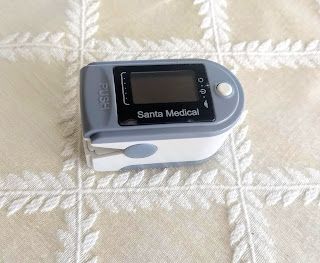Got O2?
As my husband Tom was recovering from a viral pneumonia in
2016, one of the things we did for entertainment and information was to check
his oxygen levels using a pulse oximeter – one of those clever little
electronic devices that a nurse has probably clipped onto your fingertip at some
time or another.
To make it even more fun, I would pull out my Samsung Galaxy
phone (a phone that later died from a swollen battery) and use the Samsung
Health app to check my oxygen levels by placing my finger over the phone’s light
and camera lens. Then we’d switch
devices, and he would use the phone app while I used the oximeter. Surprise!
The phone app was amazingly accurate; it agreed with the oximeter
readings every time.
 |
| A pulse oximeter for measuring oxygen saturation levels. |
But alas, in January 2020, Samsung removed the oximeter
function from the Samsung Health app. I
have a different brand of Android phone now. A few days ago, I checked the app store to see
if there is a decent oximeter app available.
After trying a few – the most promising ones – I found them to be
non-functional. Perhaps a good pulse
oximeter app is available for iPhones; I don’t know.
We still have the oximeter, however. After reading a New
York Times commentary by emergency medicine doctor Richard Levitan this
past week, Tom and I started checking our oxygen levels every evening again,
just as we did in 2016. Surely many
NYTimes readers are doing the same. Soon
it may be difficult to buy an oximeter (which should cost between $15 and $45,
available at drug stores and online).
Because Samsung used to have an accurate oximeter app, I’m
confident that app developers could once again come up with an effective app. Let’s hope they rise to the challenge. Then if everyone installed the app on their
phones, there would be no need for an oximeter in every home. We could all check our oxygen levels in the
evening, just before brushing our teeth.
Dr. Levitan said that he and his colleagues were finding
that E.R. patients without any respiratory complaints had Covid pneumonia. “And here is what really surprised us,” he
wrote. “These patients did not report
any sensation of breathing problems even though their chest X-rays showed
diffuse pneumonia and their oxygen was below normal.”
What’s a normal oxygen saturation level? In a place that is near sea level, like Sanibel
and Captiva, normal is 94 to 100 percent, according to Dr. Levitan.
Patients may have been sick for a while, staying at home, with
mild symptoms, but then would go to the hospital when they became short of
breath. “Their pneumonia had clearly
been going on for days,” wrote Dr. Levitan, “but by the time they felt they had
to go to the hospital, they were often already in critical condition.” He saw patients with remarkably low oxygen
saturations talking on their cell phones, oblivious to the distress in their
lungs.
So a key to knowing when to go to a hospital may be knowing
your blood’s oxygen saturation level. A
person who does not feel ill (yet) can evidently have oxygen levels that are
way too low. Treat your household to an
oximeter (or an oximeter app, if you can find one that works well). Be safe.

Comments
Post a Comment